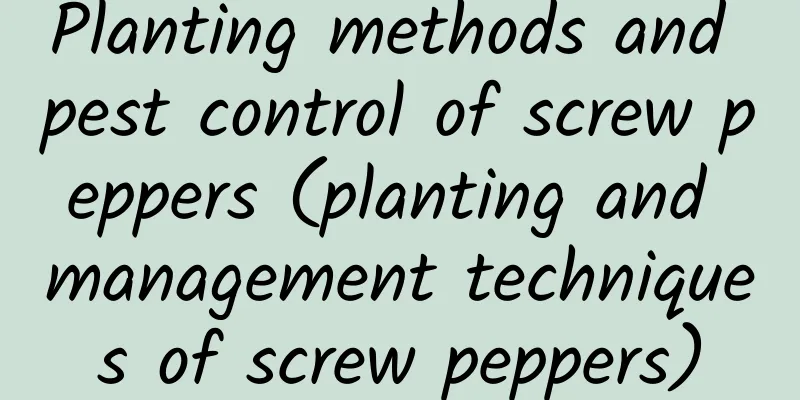Planting methods and pest control of screw peppers (planting and management techniques of screw peppers)

|
The screw pepper is a first-generation hybrid wrinkled pepper. Generally, it has higher yields than similar varieties, is cold-resistant, disease-resistant, has short internodes, dense fruit set, and dark green fruit. It is suitable for planting in Shandong, the five northwestern provinces, and Hainan. Screw peppers are planted in the facility, mainly in early spring and overwintering crops. A large overwintering crop is planted from early August to early September, and the seedlings are pulled out at the end of June of the following year. The screw peppers are harvested and put on the market during the New Year's Day and Spring Festival holidays, when the price is relatively high and the planting efficiency is the highest. The early spring crop is planted in the greenhouse in mid-to-late March, and the seedlings are pulled out in August and September. If well managed, they can grow until October or November. How to plant screw pepper1. Land preparation:Apply enough manure as base fertilizer, apply 12-15 cubic meters of well-rotted high-quality chicken manure and cow dung per acre of land. The root system of screw pepper is strong, so the soil must be deeply plowed, more than 25cm deep, to fully mix the manure and soil. 2. Planting:Planting can be done in double rows with a row spacing of 70-75cm and a plant spacing of 40-45cm, or in single row with a row spacing of 90-110cm and a plant spacing of 30-33cm. Strictly prevent flooding, lay drip irrigation belts on the ridges for planting irrigation. After customization, timely deliver fertilizer instead of medicine to slow down the seedlings, promote the rapid growth of screw peppers, and enter the flowering and fruiting period as soon as possible. 3. Environmental management from planting to seedling acclimatization:Peppers like warmth but not cold. From the time of planting to the time of seedling acclimatization, the greenhouse must be kept in a relatively high temperature and high humidity environment to promote the growth and development of the root system. Usually, the vents are not opened on the day of planting to prevent the wind from causing the seedlings to flash. 4. Water and fertilizer management:After the peppers are planted, start to stunt the seedlings to promote root growth. If there is no plastic film covering the ridges, combine weeding and tillage to loosen the soil. Stop squatting after the peppers are formed, keep the soil dry and moist, and relatively evenly moist. Water frequently with small amounts of water. Be sure to provide timely water and fertilizer during the flowering and fruiting period. You can use Green Oasis high-potassium balanced fertilizer in combination with flushing to prevent falling flowers and fruits due to lack of soil nutrients. 5. Pruning method:The pruning method is very simple and there are no strict requirements. First, remove all the side branches below the main pepper, remove the old and diseased branches on the upper part, and then double, triple or quadruple pruning can be done depending on the growth situation. The purpose is to maintain balanced growth of the entire pepper plant, avoid shade in the center, and enhance ventilation and light transmission in the field. There are many diseases in greenhouse-grown screw peppers, so disease prevention is very important. Apply sufficient fertilizer to the screw peppers to cultivate strong plants and prevent diseases in advance. Oasis Plant Protection will once again help you cultivate strong seedlings. Common diseases of screw pepperSo what are the main diseases common to screw peppers? They mainly include scab, anthracnose, blight, virus disease, white rot, bacterial wilt, etc. For diseases, the focus is on prevention, spraying medicine early, and spraying medicine first whether there is disease or not. For scab, anthracnose and viral diseases, they can be controlled by spraying agricultural streptomycin, chlorpyrifos or methyl thiophanate, ridomycin or thiophanate-methyl; viral diseases generally cause mosaic and leaf curling, which can be prevented by spraying virus A or pepper leaf curl. For the blight and bacterial wilt, prevention is the key, strengthening soil disinfection, applying more lime, or using 50% carbendazim, 500 times diluted, to drench the roots or pentachloronitrobenzene to medicate the roots in the early stage of the disease. |
Recommend
What should I do if I water Clivia too much? What is the reason for the yellowing leaves?
1. What to do if you water too much 1. Ventilatio...
Where is the best place to plant kiwifruit?
Soft kiwifruit planting area Soft-fleshed kiwifru...
Why not grow crabapples at home?
1. Why not keep it at home? When we say don't...
How often should you water green onions?
How often should you water green onions? Generall...
How to care for newly bought calla lilies
1. Lighting Calla lilies do not require much ligh...
Fruit and vegetable seed germination method
Seed soaking and germination The seed soaking and...
New technology for high-yield planting of peanuts
In soil classification, sandy loam is considered ...
Who is the patron saint of pomegranate flowers?
May Flower God 1: Zhong Dao After the light rain,...
Can Epiphyllum be grafted onto a cactus? Can it be grown indoors?
1. Is it possible to graft cactus? Epiphyllum can...
How to prune kumquat
1. Pruning When pruning young kumquat trees, ligh...
When is the best time to transplant boxwood?
Boxwood is an excellent bonsai material. Not only...
When does Aquilegia oleifera bloom?
Aquilegia flowering period Aquilegia blooms from ...
Hawthorn pest control
Hawthorn blossom rot It mainly damages leaves, ne...
Why is the “Sansevieria” always half a head shorter than others? It turns out that I didn't give it any "medicine", just 1 pill is enough
Sansevieria is one of the green leaf plants that ...
Can raw eggs be used to water Clivia?
1. Can I Of course you can. The effect of using r...









